11/1/2019
What England’s Best Have in Common
Chris Beytes
In September,
Green Profit once again joined the International Garden Center Association’s annual tour, this time in England. After several days of garden center visits, we realized we weren’t seeing many unique displays or features. Instead, we were spotting elements that the best businesses all seemed to have in common. Wanting to know more, we asked three highly respected English garden center owners—Sue Allen of Millbrook Garden Centre, Guy Topping of Barton Grange Garden Centre and Warren Haskins of Haskins Garden Centres—to comment upon what we’d observed. (Editor’s note: where they wrote “centres,” we kept it that way.)
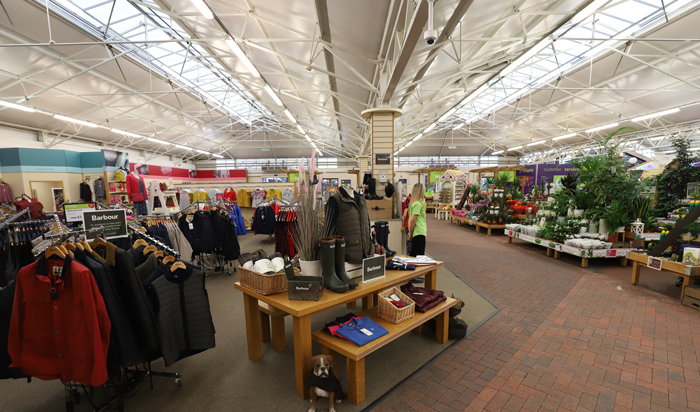
Structures: Nice, But Basic
English garden center owners seem to have figured out that soaring Crystal Palace-like greenhouses might look spectacular, but they don’t sell product. Everyone seems to have settled on a steel A-frame, widespan-style building with varying percentages of solid roof vs. clear roof over the different departments, with houseplants naturally getting more light and gifts getting less. Covered shopping retains a similar spartan structure—not flashy, but functional, spacious and efficient. And flexible, too, as it’s not a special-use sort of structure like a greenhouse is.
Pictured: The typical garden center sales structure. Is it a greenhouse frame or a commercial building? Yes.
Sue Allen: “Originally the swing towards this style of building was governed by cost when re-developing or building a new centre. Also, the local town planners seem amenable to this boring type of industrial construction. Now, we have several specialist construction companies who are very good at providing these basics, but with the odd added features to ensure the garden centres do not all end up looking the same.”
Warren Haskins: “If you look at other successful retailers, the vast majority trade in clean, tidy but not particularly fancy buildings … We invest our money in shop fittings, lighting and restaurants.”
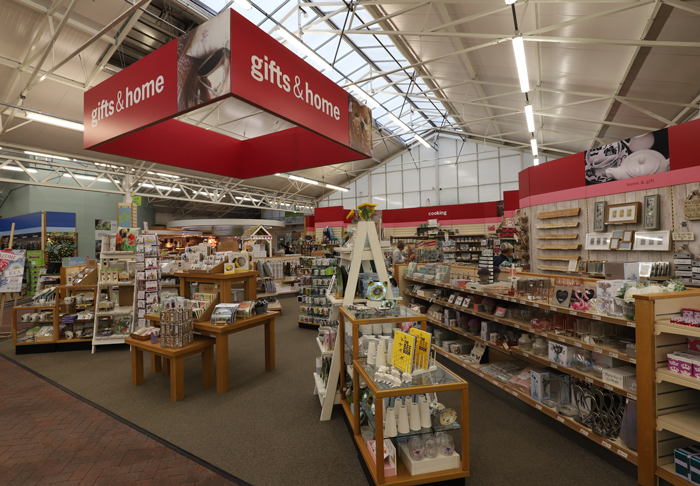
Product Range: Broad
You can find pure plant nurseries in England, but more typical is a garden center that devotes a large percentage of its interior space to non-plant categories, from gifts and greeting cards to perfume and pets. You never see them dabble in a category—if they do clothes or kitchen, they do it big. Their pet departments rival stand-alone pet stores.
Pictured: Gifts, home, kitchen, clothing, food, toys … the typical U.K. garden center carries it all to ensure year-round traffic.
This is reflected in an interesting statistic shared during IGCA’s general meeting: In the UK, plant sales as a percentage of total sales is just 19.5%—the lowest of all 19 IGCA member countries. The next closest are the Netherlands and Italy, both at a distant 42%. The U.S. scored highest, at 75%. Does that mean the UK doesn’t sell very many plants? No. It means they sell a whole lot of other products.
Sue Allen: “Years ago, we were the industry most hated by bank managers. They were very nervous about loaning to companies that had such huge seasonal swings in turnover, with the majority of income from March through to June. After the small blip of selling fresh Christmas trees in December there was little income until spring kicked in, so the introduction of Christmas decorations and gifts made a big difference. From that, all the other departments slowly developed.”
Guy Topping: “Our plant sales are actually 10% of our total sales. We still believe horticulture is at the centre of everything we do, but our other product ranges sell year-round and enable us to do what we do on such a big scale.”
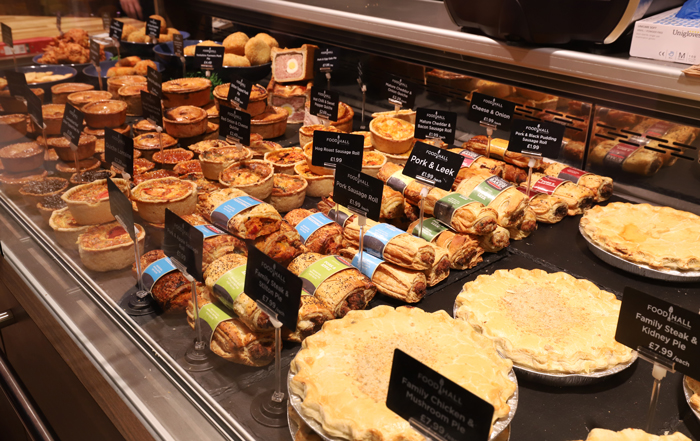
Food: Abundant
Food is a category nearly all garden centers sell, with some saying it’s 50% of their revenues. The offerings are mind-blowing—we could have eaten our way across England!
Pictured: You could eat your way across England only stopping at garden centers.
Food in a UK garden center comes in two forms: the restaurant (“catering”) and the food hall. Garden center restaurants have long been a tradition in England; Until fast food came along, the two places in town to get lunch or tea had been the pub and the garden center—and you know where the ladies chose to go. Now, most have grown beyond the simple tea and scone to become full-fledged restaurants, serving breakfast, lunch and dinner, sometimes with white tablecloths and waiters.
The food hall is generally a farm market/small grocery store that offers farm-fresh produce, butcher shop, savory pies and other heat-and-eat items, baked goods to rival the best in any specialty bakery, Italian gelato ... one wonders if the British ever cook at home!
Guy Topping: “Food-related product accounts for 60% of our sales. We have two restaurants, a Farm Shop and a Cook Shop. These categories bring people through the door 361 days of the year in all weather conditions. Our catering is also our most profitable area now. The British housewife’s appetite for cake and coffee is insatiable.”
Warren Haskins: “Our restaurants bring customers in. If we closed them, we suspect that the sales in the rest of our centre could drop by 20% or more.”
Sue Allen: A word of caution: Everyone accepts that the catering aspect of the business is the hardest to control and to staff. Poor feedback on social media can be a disaster, and it is as easy to fall out of fashion as to suddenly be the tops. If you can get it right and keep it right, then it really pays off.”

Events: Wild!
Restaurants draw them in, but so do events, with Christmastime being the biggest. Decorating starts in September, with mid-October being the kick-off to the season.
Pictured: The dragon at Pixie Manor will soon make way for Father Christmas.
According to Alyson Haywood, a British consultant who helps judge Christmas displays for the UK Garden Centre Association, Christmas decoration sales bring in an average of $500,000 (with one center reporting $3.4 million!). That’s an average of 7% of their annual turnover. And thanks to the added footfalls, December is worth 12% of the year’s sales.
The highlight at many garden centers is the “grotto,” the setting where Father Christmas greets the kiddos (whose parents plunk down $10 or $15 for the privilege). The amount of work that goes into building these displays is mind-blowing—it’s like a mini trip to Disney, complete with actors in costume.
Ruxley Manor Garden Centre is trying something similar to boost late summer sales: Pixie Manor, a multi-room extravaganza of pixies, dragons, a fairy godmother and plenty of local drama students in costume to entertain the 19,000 children and parents (based on this year’s ticket sales). August is now their third-best month.
Guy Topping: “We charge £19.99 ($24.64) for our Santa and we sell out within hours of putting the tickets on sale in September. We also run breakfast or tea with Santa and have Santa cruises on our wide-beam narrowboat, which runs up and down the Lancaster Canal. December for us is 15% of our annual sales. This is not just about commerce, however; it is engagement with the community. I know 6-year-old girls who list us as their favorite place to go. I’m sure a big part of that is because she sees Santa here every year. Customers of the future.”
Sue Allen: “We all admit that if we could put as much energy and enthusiasm into ALL our departments as we do for Christmas and other events then we would be truly amazing. However, our staff would be exhausted. Some of us are too scared to calculate the cost of all that work and creativity. However, if you know that your product offer makes the most of that increased footfall and you’ve done your sums correctly, it’s worth it.”
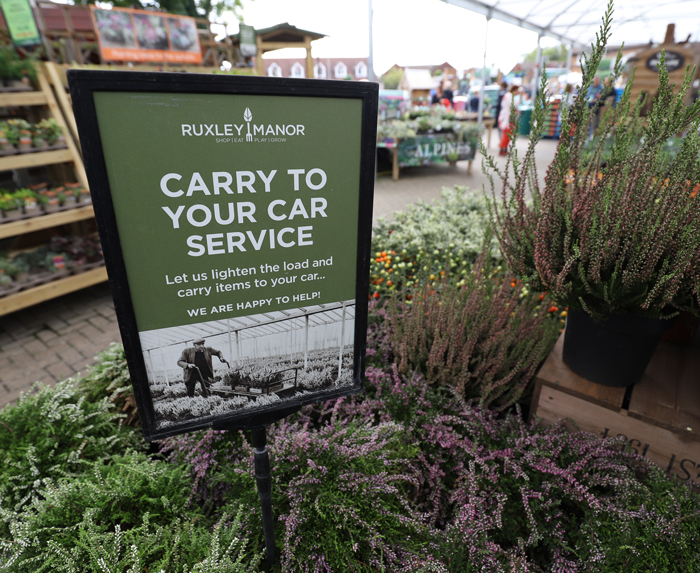
Signage: Informative
We’re not talking the typical “sun,” “shade,” “climbers” or price signs. It’s assumed those will be excellent. We’re talking information about the business. Within 10 minutes of strolling nearly every garden center, we knew about their plant guarantee (from two to five years, no questions asked); its history, with photo; the fact that they’ll help you carry, help you load or deliver it for you; and that they support local growers (one had suppliers listed by name). Also, they all celebrated autumn with autumn signage and bench tape, and they all promoted UK-grown plants.
Pictured: Excellent and abundant signage makes clear the center’s many services.
Guy Topping: This has been driven very well by the GCA (Garden Centre Association) audit, which each centre receives every year. After so many years of being told you’re not doing it, you just do it! But it IS such an obvious opportunity. For years, we all knew what a great service we were offering, but we weren’t really letting people know unless they asked.”
Sue Allen: “I still remember hand-writing our signage at our kitchen table. Now, with such amazing advances in the technology, most centres create their own quality signage simply and at a reasonable cost.”
Warren Haskins: “Signage is difficult to get right. We want to help them, stimulate them, but not bombard them.”
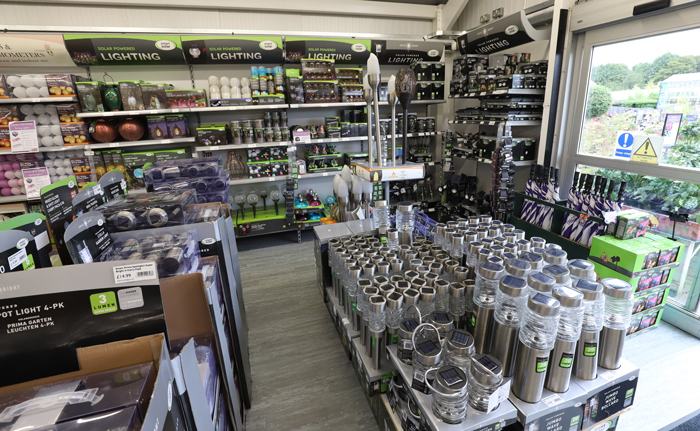
The Hot Category: Solar Lighting
At our very first stop—in fact, at a garden center we visited on our own before the tour commenced—we asked the owner if there were any extra-hot categories right now. “Solar lighting” was his answer. Sure enough, at every garden center we visited that week, we saw stacks and stacks of assorted solar lighting, at all price points. They are not giving that category away to the DIY stores!
Pictured: Not everyone needs a new patio set, but anyone can afford a few solar-powered lights for their garden.
Guy Topping: We have realized that we give a huge area of our stores over to furniture, yet 99% of our customers are not in the market for a patio furniture set. We have therefore added a variety of outdoor lifestyle products into these areas to make them shoppable to the other 99% of visitors. Solar lighting has probably been the biggest winner from that area—who doesn’t want lighting in the garden for $20?”
Sue Allen: This has been true for a few years now, with ever more efficient brighter LED lights and crazy gimmicks and designs. Some are purely decorative while others act as security lighting with timers and motion sensors. The suppliers are great at supporting ‘Special Offers’—buy two, get a third free, etc. Long may it last!”

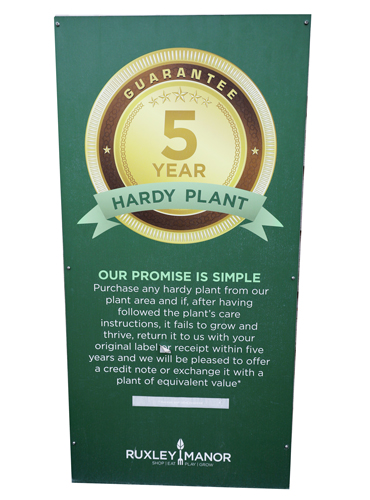
Sue Allen on Plant Guarantees
Plant guarantees are a topic of hot debate here in the U.S. But not so much in the U.K. Sue Allen explains:
“One of the requirements of GCA membership is that a centre must offer an unconditional guarantee on all hardy plants of a minimum of one year. Some now offer a lifetime guarantee.
“It took a while to convince some members, but the ‘feel good factor’ and confidence when buying a plant far outweighs the cost to us of anyone abusing the system. An angry customer waving a dead tree at you (usually in front of lots of other visitors) has the wind taken out of his sails when any member of staff is empowered to say "Oh dear, how would you like us to resolve this for you?’ And if another plant is supplied, ‘Let’s make sure its position is suitable and you are happy in your knowledge of how to care for it.’” GP